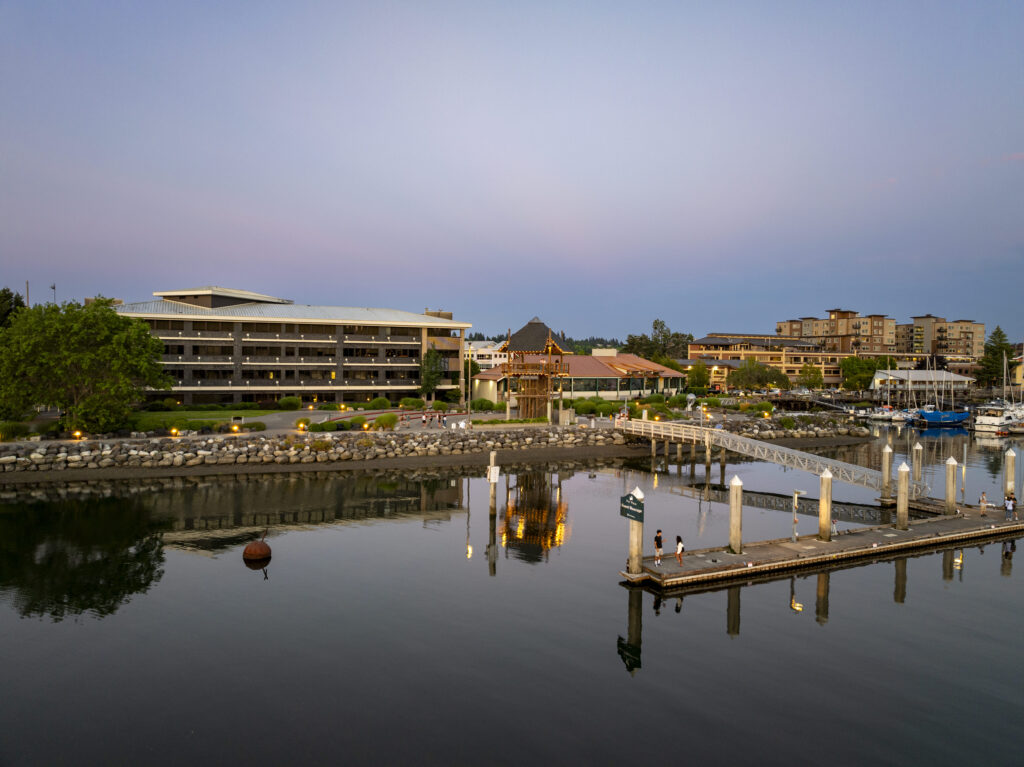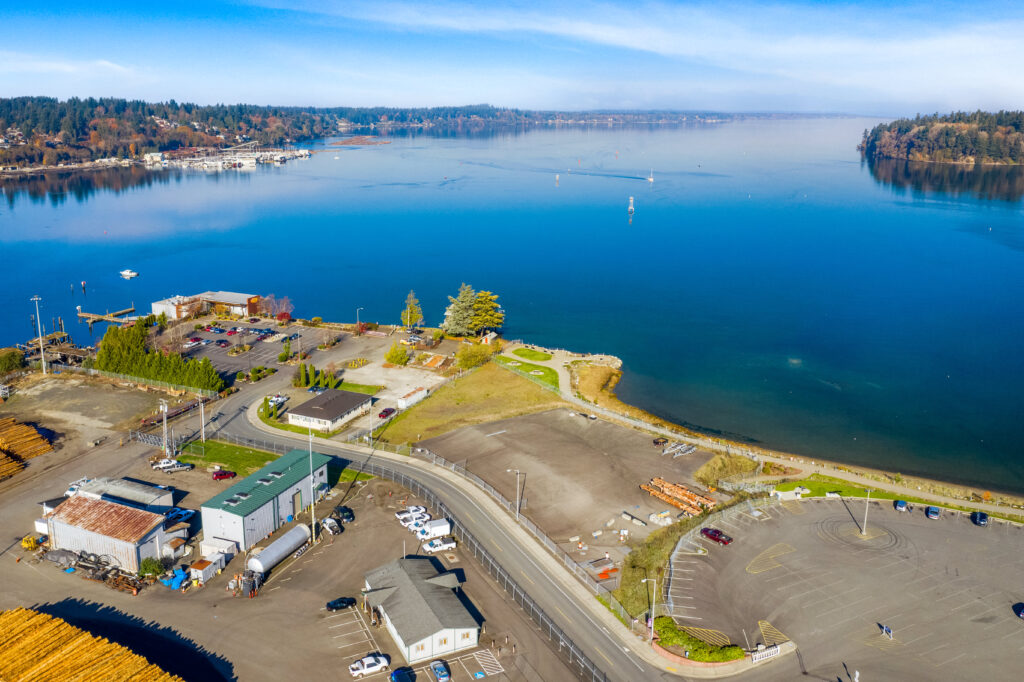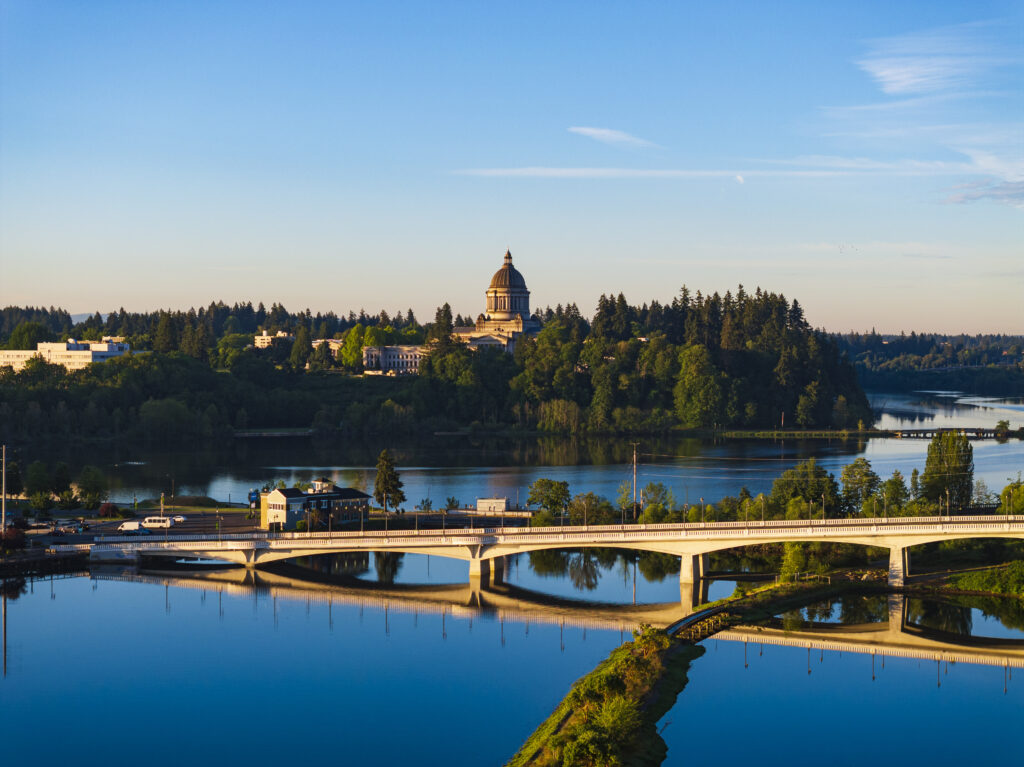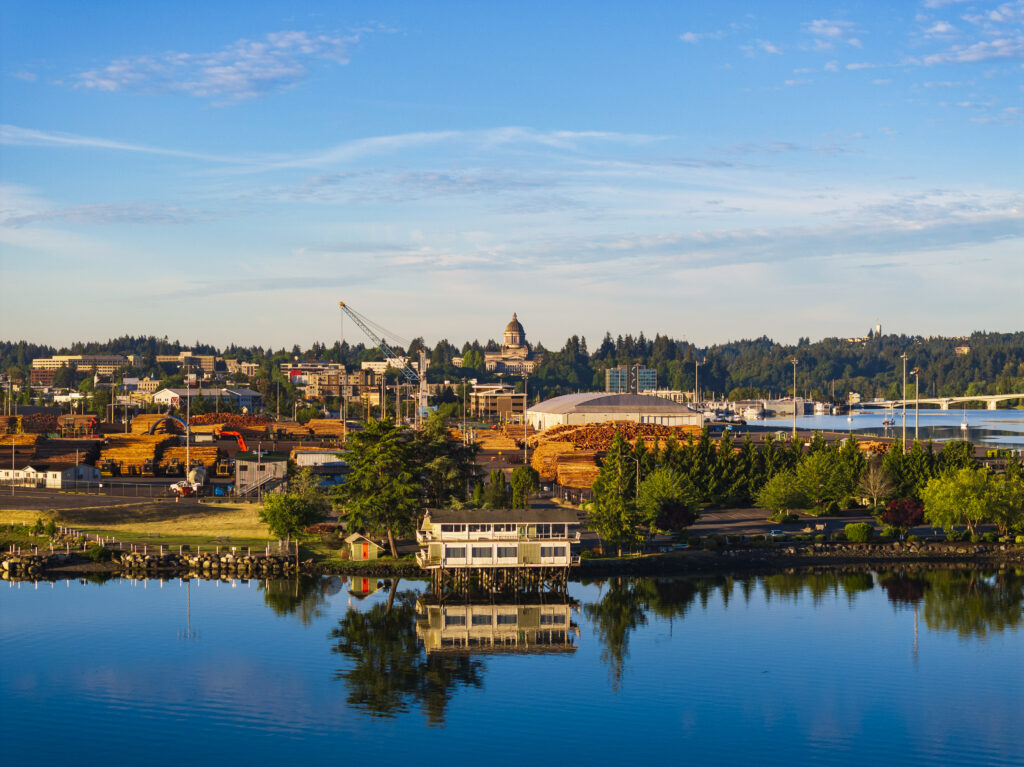Community Hot Topics
Community Hot Topics
Airport
No. The Davis Meeker tree is located outside of the Runway 17-35 Protection Zone and doesn’t play a part in any future airport plans. Removing the tree would therefore not have any effect on the procedural requirements of those approaches. Whether the tree ultimately remains or is removed will have no bearing on airport operations.
Considering the current request for proposal to replace the roof of the neighboring historic Washington State Patrol hangar, the Port has a singular concern: potential damage to the hangar in the event of a tree failure towards the airport. Such an incident could result in significant harm to the registered historic structure, impacting law enforcement’s capacity to effectively serve the Thurston County community.
For information about The Davis Meeker tree, please visit the City of Tumwater here. Davis Meeker Garry Oak Tree FAQs | City of Tumwater, WAFurther inquiries regarding the Davis Meeker Garry Oak Tree can be directed to the City of Tumwater. The city’s official platform offers a dedicated resource outlining frequently asked questions concerning this topic. For additional information, please refer to the provided link. Davis Meeker Garry Oak Tree FAQs | City of Tumwater, WA
There are no initiatives or plans to expand the footprint of the Olympia Regional Airport. In fact, a review has identified the necessity to reduce the dimensions of one of the runways, specifically the crosswind runway. This assessment indicates that the current dimensions exceed the operational requirements for the size of aircraft utilizing it. Preliminary estimations suggest a reduction in length to approximately 3,500 feet, a decrease from the existing 4,500 feet.
The Port of Olympia has facilitated a comprehensive discussion regarding airport plans, which is accessible for public viewing on YouTube. Within the discourse, pertinent dialogue addressing the nuanced understanding of the term “expansion” is located approximately at the 2-hour and 10-minute mark.
The MPU is a multi-year planning initiative that outlines the development and improvement strategies for the airport. The update is nearing completion, with final documents scheduled to go before the commission in February 2025.
The completion of the MPU was delayed in order to incorporate development alternatives that were contingent upon an approved Habitat Conservation Plan (HCP). However, due to delays with the HCP, the airport will proceed with the update without including these specific development alternatives.
The final drafts of the MPU documents were made available on the Port’s master plan update website. The complete draft is now available as of January 13th, 2025.
Yes. Starting January 13th, 2025, there will be a 30-day public comment period. During this time, the public will have the opportunity to review the final draft documents and provide comments before the commission takes action.
To learn more about the MPU, please visit the Port’s master plan update website at airport.portolympia.com/airport-master-plan/
Attend the Airport Master Plan Q&A with Airport Senior Manager Chris Paolini and Port Staff event on Wednesday, February 26 from 5:30 P.M. to 7:00 P.M. at Percival Plaza – Olympics Room – 626 Columbia Street NW, Suite 1B Olympia, WA 98501. The Port’s Airport Senior Manager, Chris Paolini, and other key Port staff will be on hand to answer questions.


Community
For over two years, the Sandman has remained upland at our Swantown Boatworks facility, awaiting significant repairs. Once a proud symbol of Olympia’s rich maritime heritage, the tug is now in critical need of support. Unfortunately, the Sandman Foundation has gradually dissolved, both in membership and financial capacity, and is no longer able to sustain the vessel’s upkeep. On July 23, 2025, at 11 a.m., an auction of the Sandman will take place. If unsold, the Port of Olympia will officially take ownership of the Sandman, 10 days following the auction.
The Sandman is registered on national, state, and city historic registries. Conversations with the City of Olympia’s Historic Preservation Office and Heritage Commission have taken place and will continue to explore options.
Now, we are asking for the community’s help. This is a unique opportunity for an individual, group, or organization to step in, take ownership, and lead the effort to preserve this treasured piece of local history.
If you or someone you know is interested—or if you have suggestions, ideas, or resources that could help—we want to hear from you. Let’s come together as a community to explore every possible path to preserving the Sandman.
For additional information about the Sandman, view the the Sandman fact sheet here.
Destination Waterfront
The Port of Olympia is inviting Expressions of Interest for the redevelopment of a 6.05-acre parcel at Swantown Marina. This project—known as the Waterfront Center at Site D—is envisioned as a premier marine-focused community destination that will support recreation, tourism, and economic vitality.
The Port seeks a qualified development partner to bring forward innovative concepts that:
- Integrate water-dependent and water-related uses
- Create engaging public spaces.
- Align with the Port’s Destination Waterfront Vision.
The project will be advanced through a public-private partnership structured around a long-term ground lease.
Responses are due November 15, 2025.
Details, submission requirements, and project updates are available through the Port’s submission portal. Submit via Bonfire
“The Commission acknowledges the community input given to this vision for the development of a Destination Waterfront and recognizes that staff will use this vision to continue to build partnerships, market Port properties, and develop project proposals for Commission consideration.” – Port of Olympia Commission – March 22, 2021 – Unanimous decision – Downing, McGregor, and Zita
The master plan outlines the long-term vision for the Port Peninsula, guiding development for decades to come. Since 2022, the Port has focused on aligning future development opportunities with environmental remediation efforts. The Port will explore how the Budd Inlet cleanup can support and enhance upland redevelopment while incorporating community input from the Vision 2050 and Destination Waterfront initiatives. Learn more about the master plan at www.portolympia.com/masterplan.
We are committed to environmental stewardship and responsibility. Environmental permitting and remediation of legacy contaminants are critical and integral steps in any development of our properties on the Port Peninsula.
As we evaluate, plan and design any development, we work closely with environmental engineers, civil engineers, structural engineers, state and local regulators and professionals with expertise developing contaminated waterfront properties. All projects must comply with the National Environmental Policy Act (NEPA) and/or the State Environmental Policy Act (SEPA). Both require a thorough evaluation of the environmental impacts of any project.
The Port’s goal is to do a thorough environmental evaluation in the form of an Environmental Impact Statement (EIS) in conjunction with the Port Peninsula Master Plan. We will soon kick off that planning effort.
We are committed to environmental protection, responsible management of our properties, and engaging with community members. To ensure community members are included in our work to develop a clean and vibrant waterfront, we engage our Citizen Advisory Committee. The advisory committee will act as a sounding board as we develop plans to clean up contaminants in Budd Inlet, develop plans for our waterfront properties and Marine Terminal, and our efforts to address sea level rise and coordinate with the Deschutes Estuary Restoration Project.
There will be opportunities in 2024 and 2025 for the public to learn more about our work, engage with us as we continue cleanup Budd Inlet, and develop the Master Plan for the Port Peninsula.
The Port of Olympia Advisory Committee has been very active and a vital partner in planning the upland development of the Budd Inlet East Bay.
Much of their work began in 2018 when the advisory committee developed a report that considered leasing versus building or buying port office space. Their assessment was based on the Port being part of the community for at least 100 years. With that in mind, their report recommends buying or constructing a building for the Port offices. You can read their Office Consolidation Report on the Advisory Committee webpage.
After that report was developed, the Port engaged in a long-term community visioning exercise, Vision 2050. Members of the Advisory Committee participated in the 14-month process to develop a community vision for the Port by 2050.
Vision 2050 included the community’s recommendation to develop the waterfront into a place people in the region could use and enjoy more. To act on this, the Port began a public engagement process to develop a master plan for the East Bay of the Port Peninsula, which was branded Destination Waterfront.
A robust public engagement process for Destination Waterfront included the Advisory Committee, business leaders, tourism representatives, and local governments. This master plan included land use recommendations, public amenities, open spaces, and the advisory committee’s recommendation to construct office space the Port owns.
Today, the Port is working to follow through on the Destination Waterfront community vision by engaging an architect to develop schematic plans and construction documents that make the project shovel-ready. Once a project is considered shovel-ready, it may qualify for funding from local, federal, and private partnerships.
You can learn more about Destination Waterfront on our website.


Environment
We are currently evaluating the level of contamination in the sediment surrounding the Port Peninsula. Last year, our research team collected over 1100 sediment samples from over 100 locations in East Bay. Those samples are now being analyzed and we expect to share the report in June. We completed a second round of sediment sampling in the West Bay of Budd Inlet this winter. We anticipate those results to start coming in this May, with a final report available by the end of the year. To learn more, visit the Budd Inlet Cleanup page.
The Port of Olympia is aware of the potential hazards of 6PPDQ and its impact on salmon and other aquatic life in Budd Inlet. The Port also recognizes the ecological, commercial and cultural importance of coho salmon to local Tribes and their Treaty Rights. Like many other organizations, our environmental team is closely following the emerging research about this chemical so that we can do our part to help address harmful impacts and be responsible stewards of the public’s resources. However, 6PPDQ is not the sole responsibility of any one group or organization. It is a widespread problem that will require a coordinated effort at the federal, state and local levels to fully address it. Learn more about the current research that Washington Department of Ecology is doing on 6PPDQ in our blog post.
Properties
The Port of Olympia is inviting Expressions of Interest for the redevelopment of a 6.05-acre parcel at Swantown Marina. This project—known as the Waterfront Center at Site D—is envisioned as a premier marine-focused community destination that will support recreation, tourism, and economic vitality.
The Port seeks a qualified development partner to bring forward innovative concepts that:
- Integrate water-dependent and water-related uses
- Create engaging public spaces.
- Align with the Port’s Destination Waterfront Vision.
The project will be advanced through a public-private partnership structured around a long-term ground lease.
Responses are due November 15, 2025.
Details, submission requirements, and project updates are available through the Port’s submission portal. Submit via Bonfire
“The Commission acknowledges the community input given to this vision for the development of a Destination Waterfront and recognizes that staff will use this vision to continue to build partnerships, market Port properties, and develop project proposals for Commission consideration.” – Port of Olympia Commission – March 22, 2021 – Unanimous decision – Downing, McGregor, and Zita
The historic Parthia tugboat is being restored and permanently installed on Port of Olympia property, as an interactive exhibit for the community. This project highlights the region’s maritime history and the significance of tugboats in Puget Sound’s working waterfront. The Parthia, built in the early 1900s, served Olympia waters for nearly four decades and was later a fixture in the annual Harbor Days tugboat races. After sinking in 2017, the South Sound Maritime Heritage Association (SSMHA) led efforts to salvage and restore the tugboat.
The Parthia will be displayed on Port property near the Olympia Farmers Market, contributing to the Maritime Washington National Heritage Area and providing an educational opportunity for visitors. The project involves local partnerships, including the SSMHA, Thomas Architecture Studios, Forma Construction, and Experience Olympia & Beyond.
Community donations are welcomed to support the Parthia Restoration & Exhibit Fund. For more information or to get involved, visit the SSMHA’s website. Maritimeoly.org, home of the South Sound Maritime Heritage Association
Read the Thurston Talk article here.
Stay tuned for updates on the exhibit’s installation, which was delayed due to weather. Visit the Port’s website and follow social media channels for rescheduled details.
At the Feb 10, 2025 Commission meeting, the Commissioners unanimously voted to approve an amendment to the 2025 Capital budget to initiate the purchase of the Dancing Goats (formerly Batdorf and Bronson) office and roastery building located at 200 Market St NE, Olympia, marking a significant step towards enhancing the Port’s administrative operations and consolidating its presence in the community. This strategic acquisition comes as a response to the recent announcement that Dillanos Coffee Roasters acquired the Pacific Northwest assets and facilities of Dancing Goats and plans to consolidate its operations in Sumner, Washington after closing down roasting operations in Olympia at the end of last year.
The Dancing Goats building, with over 22 years remaining on the current lease- 52 years if a 30-year option was implemented, occupies 1.46 acres of Port-owned land and is ideally situated adjacent to the Port’s marine terminal, Swantown Marina and Boatworks and nearby Port properties. This central location will allow the Port to streamline its operations and better serve its diverse business lines.
The Port commissioned an appraisal of the building on November 18,2024 and subsequently reached an agreement with Dancing Goats on a purchase price of $2,152,500 for the building, along with an additional $5,350 for other non-fixed assets the Port intends to acquire. Both parties have agreed to the terms of the Purchase and Sale Agreement. With the recent Commission approval on February 10 for the Executive Director to sign the agreement, the anticipated closing date is set for March 31, 2025.
This purchase will fulfill the Port’s immediate space needs and save money by eliminating the need for constructing a new facility for Port administrative offices and Commission meeting space. The Port is also considering how the acquisition of the Dancing Goats building may complement the ongoing Port Peninsula Integrated Master Plan, which aims to enhance the overall functionality and attractiveness of the Port Peninsula area. Port of Olympia Commission Approves Purchase of Dancing Goats Building
KGY has decided not to renew its land lease with the Port of Olympia and has chosen to move its operations to the Evergreen Plaza building in downtown Olympia. As a result, the Port has taken over ownership and management of the building effective December 31, 2024.
Any decisions regarding the future use of the KGY building will be made after the completion of the Port’s Port Peninsula Integrated Master Plan, which is currently underway. This comprehensive planning process will define the community and Port vision for future use of the property and surrounding area. The master plan is expected to be completed by mid-2025. Once the plan is finalized and provides a vision for the site and surrounding areas, the Port will issue a formal Request for Proposals (RFP) to solicit development ideas from those interested in the building.
Regarding the building’s condition, a recent structural assessment provided encouraging news. Contrary to initial concerns, the building is in better condition than expected. The assessment reports that the structure is in fair condition, with estimated repair costs of approximately $230,000—significantly lower than earlier projections. It is also important to note that the Port most certainly understands the legacy of KGY radio to the wider community and will seek an appropriate way to permanently honor and memorialize that legacy.



